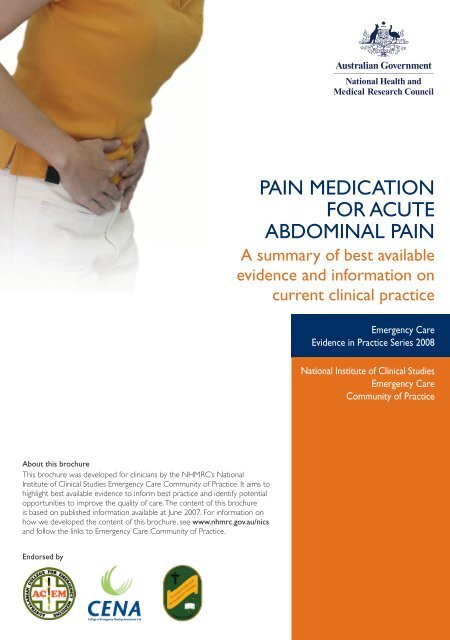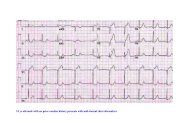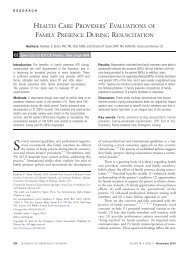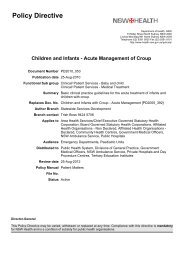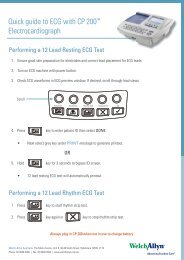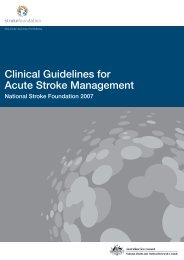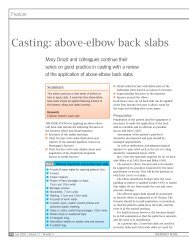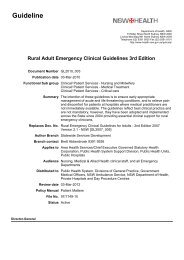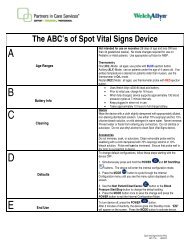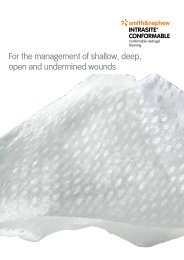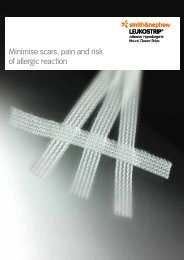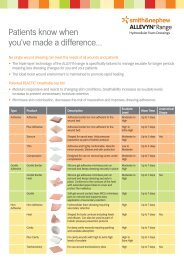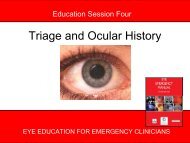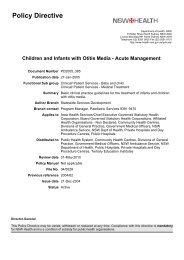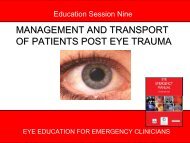Pain medication for acute abdominal pain (PDF, 120KB)
Pain medication for acute abdominal pain (PDF, 120KB)
Pain medication for acute abdominal pain (PDF, 120KB)
Create successful ePaper yourself
Turn your PDF publications into a flip-book with our unique Google optimized e-Paper software.
<strong>pain</strong> <strong>medication</strong><br />
<strong>for</strong> <strong>acute</strong><br />
<strong>abdominal</strong> <strong>pain</strong><br />
A summary of best available<br />
evidence and in<strong>for</strong>mation on<br />
current clinical practice<br />
Emergency Care<br />
Evidence in Practice Series 2008<br />
National Institute of Clinical Studies<br />
Emergency Care<br />
Community of Practice<br />
About this brochure<br />
This brochure was developed <strong>for</strong> clinicians by the NHMRC’s National<br />
Institute of Clinical Studies Emergency Care Community of Practice. It aims to<br />
highlight best available evidence to in<strong>for</strong>m best practice and identify potential<br />
opportunities to improve the quality of care. The content of this brochure<br />
is based on published in<strong>for</strong>mation available at June 2007. For in<strong>for</strong>mation on<br />
how we developed the content of this brochure, see www.nhmrc.gov.au/nics<br />
and follow the links to Emergency Care Community of Practice.<br />
Endorsed by
National Institute of Clinical Studies<br />
Emergency Care<br />
Community of Practice<br />
1. Emergency Demand Coordination Group.<br />
Hospital Admission Risk Program (HARP)<br />
Background Paper. Melbourne: Victorian<br />
Government Dept. of Human Services; 2002.<br />
2. McCaig LF, Nawar EN. National Hospital<br />
Ambulatory Medical Care Survey: 2004<br />
emergency department summary. Advance<br />
data from vital and health statistics; no 372.<br />
Hyattsville, MD National Center <strong>for</strong> Health<br />
Statistics; 2006. Available from:<br />
www.cdc.gov/nchs/nhamcs.htm<br />
3. Codde JP, Bowen S, et al. Analysis of demand<br />
and utilisation of metropolitan emergency<br />
departments in Western Australia Perth: Dept.<br />
of Health Western Australia 2006. Available<br />
from: www.health.wa.gov.au/publications<br />
4. Britt H, Miller G, et al. General practice<br />
activity in Australia 2005-06, General practice<br />
series no.19. Canberra: Australian Institute<br />
of Health and Welfare; 2007. Available from:<br />
www.aihw.gov.au<br />
5. Making Health Care Safer: A Critical Analysis<br />
of Patient Safety Practices. Technology<br />
Assessment 43. Chapter 37.1. Use of<br />
Analgesics in the Acute Abdomen. Rockville,<br />
MD: Agency <strong>for</strong> Healthcare Research and<br />
Quality; 2001. Available from:<br />
www.ahrq.gov/clinic/ptsafety/<br />
6. Cope Z. The early diagnosis of the <strong>acute</strong><br />
abdomen. New York Ox<strong>for</strong>d University<br />
Press; 1921.<br />
7. McHale PM, LoVecchio F. Narcotic analgesia in<br />
the <strong>acute</strong> abdomen – a review of prospective<br />
trials. Eur J Emerg Med. 2001;8(2):131-6.<br />
8. Kim MK, Strait RT, et al. A randomized<br />
clinical trial of analgesia in children with<br />
<strong>acute</strong> <strong>abdominal</strong> <strong>pain</strong>. Acad Emerg Med.<br />
2002;9(4):281-7.<br />
9. Attard AR, Corlett MJ, et al. Safety of early<br />
<strong>pain</strong> relief <strong>for</strong> <strong>acute</strong> <strong>abdominal</strong> <strong>pain</strong>. BMJ.<br />
1992;305(6853):554-6.<br />
10. Acute <strong>Pain</strong> Management: Scientific Evidence.<br />
2nd ed. Australian and New Zealand College<br />
of Anaesthetists and Faculty of <strong>Pain</strong> Medicine.<br />
Melbourne; 2005. Available from:<br />
www.nhmrc.gov.au<br />
11. Manterola C, Astudillo P, et al. Analgesia in<br />
patients with <strong>acute</strong> <strong>abdominal</strong> <strong>pain</strong>. Cochrane<br />
Database Syst Rev. 2007;(3):CD005660.<br />
12. Ranji SR, Goldman LE, et al. Do opiates affect<br />
the clinical evaluation of patients with <strong>acute</strong><br />
<strong>abdominal</strong> <strong>pain</strong>? JAMA. 2006;296(14):1764-74.<br />
13. Gallagher EJ, Esses D, et al. Randomized<br />
clinical trial of morphine in <strong>acute</strong> <strong>abdominal</strong><br />
<strong>pain</strong>. Ann Emerg Med. 2006;48(2):150-60,<br />
60 e1-4.<br />
14. LoVecchio F, Oster N, et al. The use of<br />
analgesics in patients with <strong>acute</strong> <strong>abdominal</strong><br />
<strong>pain</strong>. J Emerg Med. 1997;15(6):775-9.<br />
15. Mahadevan M, Graff L. Prospective<br />
randomized study of analgesic use <strong>for</strong> ED<br />
patients with right lower quadrant <strong>abdominal</strong><br />
<strong>pain</strong>. Am J Emerg Med. 2000;18(7):753-6.<br />
16. Pace S, Burke TF. Intravenous morphine<br />
<strong>for</strong> early <strong>pain</strong> relief in patients with<br />
<strong>acute</strong> <strong>abdominal</strong> <strong>pain</strong>. Acad Emerg Med.<br />
1996;3(12):1086-92.<br />
17. Thomas SH, Silen W, et al. Effects of<br />
morphine analgesia on diagnostic accuracy<br />
in Emergency Department patients with<br />
<strong>abdominal</strong> <strong>pain</strong>: a prospective, randomized<br />
trial. J Am Coll Surg. 2003;196(1):18-31.<br />
18. Vermeulen B, Morabia A, et al. Acute<br />
appendicitis: influence of early <strong>pain</strong> relief on<br />
the accuracy of clinical and US findings in<br />
the decision to operate – a randomized trial.<br />
Radiology. 1999;210(3):639-43.<br />
19. Green R, Bulloch B, et al. Early analgesia <strong>for</strong><br />
Emergency Care<br />
Evidence in Practice Series 2008<br />
National Institute of Clinical Studies<br />
<strong>pain</strong> <strong>medication</strong> <strong>for</strong> <strong>acute</strong> <strong>abdominal</strong> <strong>pain</strong><br />
Why this is important<br />
Abdominal <strong>pain</strong> is the most common reason <strong>for</strong> presentation to emergency<br />
departments in Australia (1) and internationally (2) with over 22,000 non-specific<br />
<strong>abdominal</strong> <strong>pain</strong> presentations in Victoria in 2001-02 alone. (1) It accounts <strong>for</strong><br />
around one third of all <strong>pain</strong> presentations to emergency departments, (3) a<br />
significant proportion of surgical admissions, and is a common presentation<br />
in general practice. (4) Given this large number of presentations, optimal use of<br />
analgesia <strong>for</strong> <strong>acute</strong> <strong>abdominal</strong> <strong>pain</strong> has considerable potential <strong>for</strong> beneficial<br />
impact on patient care. (5)<br />
Acute <strong>abdominal</strong> <strong>pain</strong> is a symptom of many conditions, ranging from benign<br />
to life-threatening. Establishing the cause of <strong>abdominal</strong> <strong>pain</strong> and <strong>for</strong>mulating a<br />
definitive diagnosis can be difficult. Assessment often involves diagnostic imaging<br />
investigations and consecutive examinations by more than one clinician.<br />
Opioid analgesics can be safely given be<strong>for</strong>e full<br />
assessment and diagnosis in <strong>acute</strong> <strong>abdominal</strong> <strong>pain</strong>,<br />
without increasing the risk of errors in diagnosis<br />
or treatment. (Level 1 evidence)<br />
Recommendations dating back to the 1920s discouraged the use of analgesics,<br />
particularly opioids, until the need <strong>for</strong> surgery was ruled out and a ‘reasonable’<br />
diagnosis made. (6) This recommendation was based on concerns that analgesia<br />
may mask important symptoms and lead to misdiagnosis and delayed or<br />
inappropriate treatment. (7)<br />
An opposing view was that opioid analgesia had little effect on the reflex<br />
contractions of the <strong>abdominal</strong> wall muscles that occur in conditions such as<br />
peritonitis and hence was unlikely to affect the presence of key diagnostic signs.<br />
Supporters of this view argued that administering analgesia eased unnecessary<br />
suffering and may even facilitate clinical examination. (8,9) The first trials to test the<br />
clinical application of these theories didn’t occur until the 1980s. (7)<br />
Best available evidence<br />
The Australian and New Zealand College of Anaesthetists 2005 publication, Acute<br />
<strong>Pain</strong> Management: Scientific Evidence, clearly states that provision of <strong>pain</strong> relief<br />
does not interfere with the diagnostic process in <strong>acute</strong> <strong>abdominal</strong> <strong>pain</strong> in adults<br />
or children. (10)<br />
This recommendation is consistent with two systematic reviews and an additional<br />
randomised controlled trial that examined the effect of opioid analgesia on<br />
diagnosis and management of patients with <strong>acute</strong> <strong>abdominal</strong> <strong>pain</strong>, while awaiting<br />
definitive diagnosis and final treatment decisions. (11-13)<br />
The Cochrane systematic review examined six adult studies (9, 14-18) and found<br />
no difference between opioid and control groups in changes in the physical<br />
examination, errors in treatment or diagnosis, or morbidity. (11) However, it found<br />
significant reduction in <strong>pain</strong> intensity and improved patient com<strong>for</strong>t <strong>for</strong> those<br />
receiving opioids.<br />
The second systematic review (12) examined data from three paediatric (8,19,20) and<br />
nine adult (9, 14-18, 21-23) randomised and quasi-randomised controlled trials. On<br />
combining the results of all these trials, this review found an increased frequency<br />
of changes in the symptoms noted during physical examination of those patients<br />
who had received opioid analgesia. Identified changes included both increases
<strong>pain</strong> <strong>medication</strong> <strong>for</strong> <strong>acute</strong> <strong>abdominal</strong> <strong>pain</strong><br />
and decreases in a range of signs; <strong>for</strong> example, localisation of the site of<br />
tenderness, bowel sounds, and voluntary and involuntary guarding. Most of<br />
these studies did not distinguish between potentially beneficial changes and<br />
those that were potentially detrimental. Importantly, these changes did not result<br />
in an increase in management errors. This second review found no difference<br />
in the rate of incorrect management decisions, such as delayed or unnecessary<br />
surgery, between opioid and placebo groups. There was a trend toward fewer<br />
unnecessary operations <strong>for</strong> patients who received opioids. (12) This was true <strong>for</strong><br />
both adult and paediatric trials.<br />
The randomised controlled trial published after completion of the searches <strong>for</strong><br />
these reviews found no difference in the accuracy rate of emergency physicians’<br />
provisional diagnosis between groups of patients administered morphine<br />
or placebo. (13)<br />
These systematic reviews, and an additional Australian review of the available<br />
literature (24) identified no randomised or quasi-randomised trials that examined<br />
the effect of opioids on patient recall and ability to provide a clinical history, the<br />
effect of non-opioid <strong>pain</strong> <strong>medication</strong>s, or the care of children under four years<br />
of age. (12,24)<br />
Current practice<br />
Internationally, surveys in adult (25-27) and paediatric (28) emergency care settings<br />
have found that emergency physicians and surgeons commonly prefer to<br />
withhold analgesia <strong>for</strong> <strong>acute</strong> <strong>abdominal</strong> <strong>pain</strong>, even when they do not believe<br />
that opiate <strong>medication</strong> changes important examination findings. (25)<br />
Audits of emergency care practice have found that less than one third of adult<br />
or paediatric patients with <strong>acute</strong> <strong>abdominal</strong> <strong>pain</strong> received opioids (29,30) or any<br />
analgesic <strong>medication</strong>. (31,32) Where analgesia is given, it may not be adequate<br />
to provide relief from <strong>pain</strong>. One study in paediatric emergency care found<br />
that the analgesics were administered at sub-therapeutic doses in 14 per cent<br />
of patients. (31) These studies did not comment on what the ideal rates of analgesia<br />
use should have been. Another study found use of opioid analgesia <strong>for</strong> adults<br />
with <strong>acute</strong> <strong>abdominal</strong> <strong>pain</strong> more than doubled from 23 per cent in 1998 to<br />
53 per cent in 2003, along with a dramatic increase in <strong>pain</strong> score documentation,<br />
following intensive campaigns about the importance of managing <strong>pain</strong> symptoms. (30)<br />
Practice audits have also identified delays in the time taken <strong>for</strong> patients to receive<br />
<strong>pain</strong> <strong>medication</strong>. (26,30,33) Delay is especially likely <strong>for</strong> patients admitted to hospital<br />
wards from the emergency department, <strong>for</strong> whom average times to receive<br />
analgesia of between five and six hours have been identified. (26,34) One study<br />
found that only around 10 per cent of those patients who had seen a general<br />
practitioner received analgesia prior to coming to the emergency department. (26)<br />
Preliminary results from a 2007 retrospective audit of 36 Australian emergency<br />
departments and 10 Australian and New Zealand paediatric emergency<br />
departments suggest there is variation between departments in the practice<br />
of withholding <strong>pain</strong> <strong>medication</strong> and the average time taken to administer<br />
<strong>pain</strong> relief. (35)<br />
Implications <strong>for</strong> practice<br />
• There is no evidence to support withholding analgesia <strong>for</strong> <strong>acute</strong><br />
<strong>abdominal</strong> <strong>pain</strong> in adults or children.<br />
• Opioid analgesics improve patient com<strong>for</strong>t, without increasing the risk<br />
of errors in diagnosis or treatment, and can be safely given be<strong>for</strong>e full<br />
assessment and diagnosis in <strong>acute</strong> <strong>abdominal</strong> <strong>pain</strong>. (Level I evidence)<br />
children with <strong>acute</strong> <strong>abdominal</strong> <strong>pain</strong>. Pediatrics.<br />
2005;116(4):978-83.<br />
20. Kokki H, Lintula H, et al. Oxycodone vs placebo<br />
in children with undifferentiated <strong>abdominal</strong><br />
<strong>pain</strong>: a randomized, double-blind clinical trial of<br />
the effect of analgesia on diagnostic accuracy.<br />
Arch Pediatr Adolesc Med. 2005;159(4):320-5.<br />
21. Zoltie N, Cust MP. Analgesia in the <strong>acute</strong> abdomen.<br />
Ann R Coll Surg Engl. 1986;68(4):209-10.<br />
22. Garyfollou G, Grillo A, et al. A controlled trial<br />
of fentanyl analgesia in emergency department<br />
patients with <strong>abdominal</strong> <strong>pain</strong>: can treatment<br />
obscure the diagnosis? [abstract]. Acad Emerg<br />
Med. 1997;4:424.<br />
23. Wolfe JM, Smithline HA, et al. Does morphine<br />
change the physical examination in patients<br />
with <strong>acute</strong> appendicitis? Am J Emerg Med.<br />
2004;22(4):280-5.<br />
24. Reid J, Rumbold G, et al. Evidence Review:<br />
Analgesic use in <strong>acute</strong> <strong>abdominal</strong> <strong>pain</strong>.<br />
Melbourne: Centre <strong>for</strong> Clinical Effectiveness<br />
2007. Available from:<br />
www.mihsr.monash.org/cce/evidence.html<br />
25. Wolfe JM, Lein DY, et al. Analgesic<br />
administration to patients with an <strong>acute</strong><br />
abdomen: a survey of emergency medicine<br />
physicians. Am J Emerg Med. 2000;18(3):250-3.<br />
26. Tait IS, Ionescu MV, et al. Do patients with <strong>acute</strong><br />
<strong>abdominal</strong> <strong>pain</strong> wait unduly long <strong>for</strong> analgesia?<br />
J R Coll Surg Edinb. 1999;44(3):181-4.<br />
27. Graber MA, Ely JW, et al. In<strong>for</strong>med consent<br />
and general surgeons’ attitudes toward the use<br />
of <strong>pain</strong> <strong>medication</strong> in the <strong>acute</strong> abdomen.<br />
Am J Emerg Med. 1999;17(2):113-6.<br />
28. Kim MK, Galustyan S, et al. Analgesia <strong>for</strong><br />
children with <strong>acute</strong> <strong>abdominal</strong> <strong>pain</strong>: a survey<br />
of pediatric emergency physicians and pediatric<br />
surgeons. Pediatrics. 2003;112(5):1122-6.<br />
29. Lee JS, Stiell IG, et al. Adverse outcomes<br />
and opioid analgesic administration in<br />
<strong>acute</strong> <strong>abdominal</strong> <strong>pain</strong>. Acad Emerg Med.<br />
2000;7(9):980-7.<br />
30. Neighbor ML, Baird CH, et al. Changing opioid<br />
use <strong>for</strong> right lower quadrant <strong>abdominal</strong> <strong>pain</strong> in<br />
the emergency department. Acad Emerg Med.<br />
2005;12(12):1216-20.<br />
31. Goldman RD, Crum D, et al. Analgesia<br />
administration <strong>for</strong> <strong>acute</strong> <strong>abdominal</strong> <strong>pain</strong> in the<br />
pediatric emergency department. Pediatr Emerg<br />
Care. 2006;22(1):18-21.<br />
32. Pagel JM, Kerr K, et al. Retrospective analysis<br />
of a guideline <strong>for</strong> evaluating nontraumatic<br />
<strong>abdominal</strong> <strong>pain</strong> in older patients presenting to<br />
the emergency department. J Clin Outcomes<br />
Manag. 2003;10(11):589-95.<br />
33. Green RS, Kabani A, et al. Analgesic use in<br />
children with <strong>acute</strong> <strong>abdominal</strong> <strong>pain</strong>. Pediatr<br />
Emerg Care. 2004;20(11):725-9.<br />
34. Shabbir J, Ridgway PF, et al. Administration of<br />
analgesia <strong>for</strong> <strong>acute</strong> <strong>abdominal</strong> <strong>pain</strong> sufferers in<br />
the accident and emergency setting. Eur J Emerg<br />
Med. 2004;11(6):309-12.<br />
35. National Institute of Clinical Studies. Audit<br />
of Australian emergency department <strong>pain</strong><br />
management practice. Canberra: NHMRC; 2007.<br />
Available from: www.nhmrc.gov.au/nics<br />
Emergency Care<br />
Evidence in Practice Series 2008<br />
National Institute of Clinical Studies
Levels of evidence<br />
I Evidence obtained from a systematic review of all relevant randomised controlled trials<br />
II Evidence obtained from at least one properly-designed randomised controlled trial<br />
III-1 Evidence obtained from well-designed pseudorandomised controlled trials<br />
III-2 Evidence obtained from comparative studies<br />
III-3 Evidence obtained from comparative studies with historical control, two or more<br />
single arm studies, or interrupted time series without a parallel control group<br />
IV Evidence obtained from case series, either post-test or pre-test/post-test<br />
CPP Recommended best practice based on clinical experience and expert opinion<br />
The National Institute of Clinical Studies<br />
(NICS) works to improve health care<br />
by getting health and medical research<br />
into practice. NICS is an institute of the<br />
National Health and Medical Research<br />
Council (NHMRC), Australia’s peak body<br />
<strong>for</strong> supporting health and<br />
medical research.<br />
NICS supports the Emergency<br />
Care Community of Practice <strong>for</strong> all<br />
individuals and organisations involved<br />
in the delivery of emergency care to<br />
share their knowledge and expertise<br />
in implementation of best practice to<br />
improve patient care<br />
© Australian Government 2008<br />
Paper-based publications<br />
This work is copyright. Apart from any use as<br />
permitted under the Copyright Act 1968, no part may<br />
be reproduced by any process without prior written<br />
permission from the Commonwealth available from<br />
the Attorney General’s Department. Requests and<br />
inquiries concerning reproduction and rights should<br />
be addressed to the Commonwealth Copyright<br />
Administration, Attorney General’s Department,<br />
Robert Garran Offices, National Circuit, Canberra,<br />
ACT, 2600 or posted at: http://www.ag.gov.au/cca.<br />
Electronic documents<br />
This work is copyright. You may download, display,<br />
print and reproduce this material in unaltered <strong>for</strong>m<br />
only (retaining this notice) <strong>for</strong> your personal,<br />
non-commercial use or use within your organisation.<br />
Apart from any use as permitted under the Copyright<br />
Act 1968, all other rights are reserved. Requests<br />
<strong>for</strong> further authorisation should be directed to the<br />
Commonwealth Copyright Administration, Attorney<br />
General’s Department, Robert Garran Offices,<br />
National Circuit, Canberra, ACT, 2600 or posted at:<br />
http://www.ag.gov.au/cca.<br />
Emergency Care<br />
Evidence in Practice Series 2008<br />
National Institute of Clinical Studies<br />
Acknowledgements<br />
This brochure was prepared by Michaela Willet, NICS, with support from NICS<br />
colleagues and the Centre <strong>for</strong> Clinical Effectiveness. Thank you to the following people<br />
<strong>for</strong> their helpful contributions and suggestions, and/or <strong>for</strong> reviewing this document:<br />
Wendy Fenton, Margaret Fry, Russell Gruen, Claire Harris, Anna Holdgate,<br />
Kerri Holzhauser, Megan Hosken, Sue Ieraci, Anne-Maree Kelly, Jonathan Knott,<br />
Marian Lee, Jane Reid, Ramon Shaban, Lynton Stacey, Simone Taylor, Michael Yeoh.<br />
Endorsed by<br />
Australasian College <strong>for</strong> Emergency Medicine<br />
College of Emergency Nursing Australasia<br />
Australian College of Emergency Nursing<br />
For more in<strong>for</strong>mation<br />
Emergency Care Community of Practice<br />
National Institute of Clinical Studies<br />
National Health and Medical Research Council<br />
GPO Box 4530, Melbourne VIC 3001 Australia<br />
T: 61 3 8866 0400<br />
F: 61 3 8866 0499<br />
E: emergencycare@nhmrc.gov.au<br />
W: www.nhmrc.gov.au/nics<br />
Suggested citation<br />
National Institute of Clinical Studies, <strong>Pain</strong> <strong>medication</strong> <strong>for</strong> <strong>acute</strong> <strong>abdominal</strong> <strong>pain</strong> Canberra:<br />
National Health and Medical Research Council; 2008<br />
ISBN: 1 86496 403 0<br />
ISBN Online: 1 86496 409 X<br />
Disclaimer<br />
Health professionals are advised to use clinical judgement when applying in<strong>for</strong>mation<br />
contained in this document. Every ef<strong>for</strong>t has been made to ensure that the<br />
in<strong>for</strong>mation contained in this document is correct as at the time of printing, but<br />
the Commonwealth accepts no liability <strong>for</strong> any loss or damage resulting directly<br />
or indirectly from reliance on this in<strong>for</strong>mation or from subsequent changes to the<br />
currency of the in<strong>for</strong>mation.


